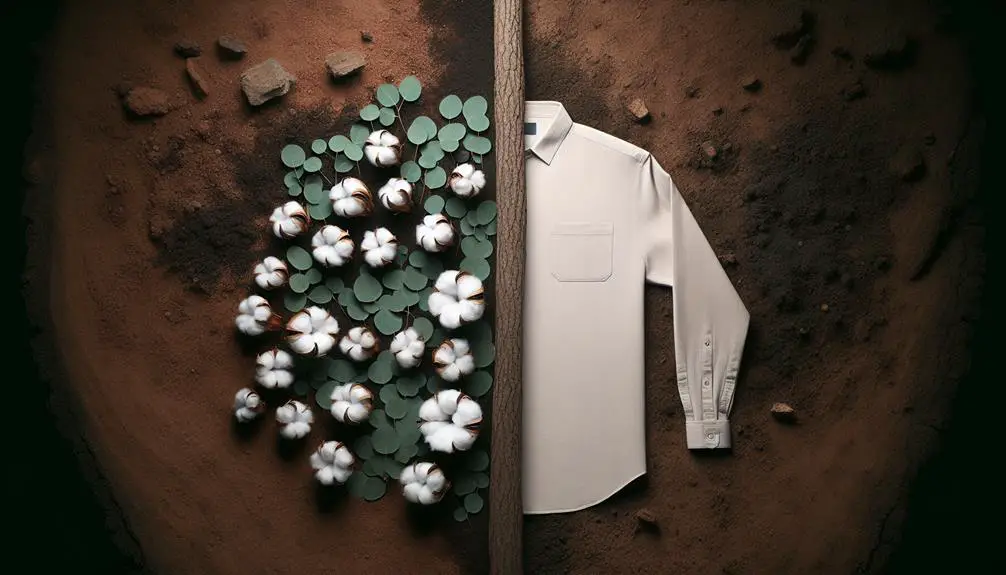I think Tencel Lyocell has some serious advantages over cotton. It's made from eucalyptus trees, uses a closed-loop system that recycles most of its water and chemicals, making it pretty eco-friendly. Plus, it consumes way less water and energy. Comfort-wise, Tencel is smoother and offers better moisture management, which means it keeps you cooler and drier. That's a big win for me, especially when it gets hot. Cotton is comfy and easy to find, but it's not as sustainable or efficient. There's quite a bit more to this if you're looking to make a switch or just wanna know what's best for you.
Table of Contents
Key Takeaways
- Tencel Lyocell is more eco-friendly, utilizing a closed-loop production that recycles water and chemicals.
- It offers superior moisture management, keeping the skin dry and comfortable, ideal for sensitive skin.
- Tencel Lyocell is more breathable and better at heat management than cotton, making it suitable for hot sleepers.
- The production of Tencel Lyocell consumes less water and energy compared to that of cotton.
- Tencel fibers are biodegradable and crafted with minimal waste, enhancing their environmental appeal.
Understanding Tencel Lyocell
Let's dive into what Tencel Lyocell really is and why it's catching the eye of eco-conscious consumers. Tencel Lyocell, known for its strength and moisture-wicking capabilities, is a standout in the world of sustainable fabrics. It's crafted from wood pulp, mainly from eucalyptus trees, which speaks volumes about its eco-friendliness. Not only is the source renewable, but the way it's turned into fabric also sets it apart. The solvent-based process used to produce Tencel Lyocell is significantly gentler on the environment than traditional methods used for other fabrics.
What really makes Tencel Lyocell shine, especially for folks like me who prioritize sustainability, is how it marries comfort with eco-consciousness. This fabric isn't just strong and great at wicking away moisture, making it ideal for hot sleepers, but it's also incredibly soft and even silkier than cotton. For those of us with sensitive skin, its gentle, breathable nature is a godsend. So, when you're looking for a fabric that supports both the planet and your comfort, Tencel Lyocell is a no-brainer. It's a prime example of how we can enjoy luxury without sacrificing our environmental principles.
The Basics of Cotton
Now, let's talk about how cotton is grown and its impact on the environment.
I've learned that the way cotton is cultivated can vary widely, and this has big effects on our planet.
We'll look into what these growing practices mean for sustainability and why it matters.
Cotton Growing Practices
Growing cotton starts with understanding the basics of the plant's needs: warm climates, plenty of sunlight, and fertile soil. Cotton plants thrive where these conditions are met, like in the US, China, and India.
In conventional cotton cultivation, farmers often use pesticides and synthetic fertilizers, which can be harsh on the environment. On the other hand, organic cotton avoids synthetic chemicals, focusing on soil health and water conservation. This is part of sustainable cotton farming, which not only aims to minimize environmental impact but also upholds ethical labor practices and fair trade principles.
The cotton industry is at a crossroads, choosing between traditional methods and the sustainable path that respects both the planet and its people.
Cotton's Environmental Impact
Cotton's thirst for water is huge, needing about 2,700 liters just to make one t-shirt. It's a water-intensive crop that's also heavy on chemicals. Think about this, it uses about 16% of the world's insecticides and 7% of pesticides. That's a lot for just one type of plant!
Here's what hits hard:
- Soil Health: Without sustainable practices, cotton leads to soil erosion.
- Chemical Inputs: Regular cotton farming dumps tons of pesticides that ain't great for the earth.
- Water Use: It slurps up water like nobody's business.
Organic cotton production and sustainable cotton initiatives are stepping up to tackle these issues, promoting soil health and fair labor practices. We gotta keep pushing for these better practices!
Production Processes Compared
Let's take a closer look at how Tencel lyocell and cotton are made to see what sets them apart.
I'll talk about where they come from, how they affect the environment, and what goes into making them in terms of energy and water.
It's important to understand these differences to figure out which one might be the better choice.
Raw Material Sourcing
When comparing the raw material sourcing of Tencel lyocell and cotton, significant differences emerge in their production processes. Tencel lyocell comes from eucalyptus wood fibers while cotton is harvested from cotton plants. Here's what stands out:
- Chemical Process: Tencel lyocell uses a chemical solvent in a closed-loop system, recycling 99% of materials, making it incredibly efficient.
- Texture Benefits: Known for its soft, silky feel, Tencel is a hit for folks with sensitive skin, unlike the variable textures of cotton.
- Breathability: Tencel outshines cotton in breathability, which is a game-changer for comfort and hygiene.
I'm leaning towards Tencel for its thoughtful production process and the clear benefits it offers, especially for sensitive skin!
Environmental Impact
Diving into the environmental impact, Tencel lyocell clearly has a leg up on cotton due to its closed-loop production process. Let's look at how they stack up:
| Aspect | Tencel Lyocell | Cotton |
|---|---|---|
| Base Material | Wood pulp | Cotton plant fibers |
| Production Complexity | Intricate, fine fiber creation | Simpler, traditional spinning |
| Solvent Use | 99% recycled, minimal waste | Higher waste, less recycled |
| Texture | Smoother, finer fibers | Coarser fibers |
| Sustainability | More sustainable, eco-friendly | Less eco-friendly |
Tencel lyocell's production process is not only more sustainable but also turns out fibers that are smoother and finer, marking it as a superior, eco-friendly choice.
Energy and Water Use
Comparing their production processes, Tencel lyocell uses significantly less water and energy than cotton. Let's dive right into how both are made. While cotton relies heavily on water for growing and processing, Tencel's approach is way cooler and greener.
Here's why Tencel rocks:
- Less Thirsty: Tencel needs less water because it's made from wood pulp, which doesn't require irrigation.
- Energy Saver: The production process is super efficient, using less energy mainly because 99% of the solvent is recycled.
- Eco-Friendly Solvent: This solvent used in making Tencel is less harsh on the environment, which makes the whole process cleaner.
Environmental Impact Analysis
Let's take a close look at how Tencel lyocell stacks up against cotton in terms of their environmental impacts.
Straight up, Tencel lyocell shines as the more sustainable choice. Why? Well, it's sourced from eucalyptus trees, which are pretty fast-growing and don't need much to thrive. This makes Tencel lyocell significantly more environmentally friendly right from the get-go.
Now, talking about the manufacturing bit, Tencel lyocell uses this neat method called closed-loop production. This basically means most of the chemicals and water used to turn those eucalyptus trees into soft, comfy fibers are recycled back into the system instead of being dumped somewhere. This process slashes the water and energy consumption big time, leading to a much lower environmental impact compared to how traditional cotton is produced.
And let's not forget about cotton farming, which is notorious for its heavy pesticide use and massive water needs. Tencel lyocell skips all that drama, sticking with eco-friendly practices that make a real difference.
Comfort and Durability Differences
When it comes to comfort and durability, Tencel lyocell often outshines traditional cotton. Let's break down why.
Firstly, if you're looking for something that feels luxurious, Tencel lyocell is your go-to. It's softer and silkier than most cotton, giving you that comfy feel you crave. Plus, it's super breathable and moisture-wicking, which is a game-changer for anyone who hates waking up sweaty.
Here are three key points to consider about Tencel lyocell:
- Breathability: Tencel lyocell fibers are structured to regulate absorption and release of moisture, making them highly breathable compared to cotton.
- Moisture-wicking: It pulls moisture away from your skin, keeping you dry and comfortable throughout the night.
- Eco-friendly: Not only does it feel good, but you can also feel good about using it. It's made in a more sustainable way than conventional cotton.
While Tencel lyocell does require a bit more care in laundering compared to the easy wash-and-go nature of cotton, its comfort and durability features, combined with its eco-friendly production, might just tip the scales in its favor for many.
Costs: Tencel Vs. Cotton
Tencel lyocell sheets usually cost more than cotton ones because of how they're made and where their materials come from. The production process for Tencel lyocell is pretty high-tech and involves transforming wood pulp into fiber. This method, while eco-friendly, ramps up the material costs. Plus, the sources for Tencel's wood pulp, like eucalyptus trees, can add to the price due to their specific growing conditions and sustainability practices.
On the flip side, cotton sheets are easier on the wallet. They're a hit for folks who want comfy bedding without breaking the bank. Cotton's affordability comes from its less complicated production process and the widespread availability of cotton plants. This makes cotton sheets a budget-friendly choice across various price points, catering to all sorts of budgets.
Now, if you're eyeballing something a tad more luxurious, Tencel lyocell sheets might be your go-to. They're often seen as a premium choice due to their softness and sustainability perks, but this does reflect in a higher price point. So, when you're deciding between Tencel lyocell and cotton, think about what's best for your budget and bedroom vibes.
Allergy Considerations
When it comes to allergies, both Tencel and cotton have their perks, but let's see how they really stack up.
We'll look at their hypoallergenic properties, how they respond to sensitive skin, and their allergen retention rates.
I'm curious to see which one comes out on top for folks like us who need to keep skin reactions at bay.
Hypoallergenic Properties Comparison
Both cotton and Tencel lyocell are great choices for folks with allergies because they're naturally hypoallergenic. If you're wondering why, let me break it down:
- Natural Properties: Both fibers boast natural hypoallergenic properties, making them less likely to trigger allergies.
- Moisture-Wicking: They excel at moisture management. Cotton and Tencel lyocell pull moisture away from the skin, which helps prevent the growth of allergens like mold and dust mites.
- Breathability: Their breathability ensures that you stay dry and comfortable, reducing the risk of skin irritation.
Choosing between cotton and Tencel lyocell comes down to personal preference, but both are solid options for those with sensitive skin or allergies.
Skin Sensitivity Responses
Considering skin sensitivities, it's crucial to note that Tencel lyocell is often gentler than cotton, which can be a game-changer for allergy sufferers. You see, Tencel lyocell isn't only hypoallergenic but also super gentle on skin. This makes it a top pick for anyone with allergies or conditions like eczema and dermatitis. Unlike cotton, Tencel doesn't hold onto moisture, thanks to its moisture-wicking abilities. This means it keeps your skin dry and comfortable, reducing the risk of irritation.
Cotton, while also hypoallergenic, sometimes carries chemical residues from pesticides, which isn't ideal for sensitive skin. So, if you're struggling with skin issues, Tencel lyocell might just be the better choice for you.
Allergen Retention Rates
Building on skin sensitivity, let's now explore how Tencel lyocell stacks up against cotton in terms of allergen retention rates. If you're like me, wanting a sneeze-free night, here's why Tencel lyocell might just be your bedroom's new best friend:
- Lower Allergen Retention: Tencel lyocell doesn't hold onto allergens as much as cotton does. This means fewer sniffles for us allergy sufferers.
- Dust Mite Defense: Its smooth surface is a tough playground for dust mites, unlike cotton's rougher texture.
- Bacteria Growth Barrier: The fabric's ability to inhibit bacteria keeps your sleeping environment healthier.
Care and Maintenance
Caring for Tencel Lyocell sheets involves gently laundering them with a mild detergent to keep them soft and intact. It's essential to avoid high heat when drying these sheets, as it can really mess with their quality. Always opt for low heat or air drying to keep them in top shape. If you've got some stubborn wrinkles, don't worry, just set your iron to low heat and gently press them out.
When it comes to storing your Tencel Lyocell sheets, you'll want to keep them in a cool, dry place. Avoid damp areas like basements or attics where moisture can do some serious damage. Regular care also includes rotating and flipping your sheets on the bed to ensure they wear evenly. This little bit of extra effort can significantly extend their life.
Stylistic Variations
Tencel Lyocell not only feels softer and silkier than most cottons, but it also comes in a range of stylish options that cater to various tastes and preferences. When it comes to adding flair to my wardrobe or bedroom, I've noticed that this fabric truly shines with its versatility.
Here's why I think Tencel Lyocell stands out in stylistic variations:
- Diverse Weaves: Unlike cotton, which sticks mainly to traditional weaves like twill and sateen, Tencel can be transformed into a variety of textures that are both appealing and functional.
- Rich Colors: This material holds dyes well, resulting in deeper, more vibrant colors that last longer without fading. This is great for anyone looking to keep their style fresh and bold.
- Eco-Chic: For those of us wanting to maintain an eco-friendly lifestyle, Tencel offers a fashion-forward choice without sacrificing our green ideals.
The production process of Tencel, although more involved, supports sustainable practices, making it a top choice for the environmentally conscious. As someone who's into both the feel and the impact of what I wear and use, switching to Tencel Lyocell has been a no-brainer.
The Better Choice for Heat
While I've touched on Tencel Lyocell's style benefits, it's also worth noting how well it manages heat compared to cotton. If you're someone who often finds themselves too hot at night or battles with night sweats, then Tencel Lyocell might just be the game-changer you're looking for. This fabric is designed with superior heat regulation in mind, thanks to its breathable and moisture-wicking properties.
Tencel Lyocell's ability to keep you cool and dry is a massive plus for hot sleepers. Unlike cotton, which tends to retain more heat, Tencel Lyocell facilitates a cooler sleep environment. This is crucial because a cooler sleep surface can help lower your body temperature, leading to quicker sleep onset and less nighttime awakenings. Everyone knows a good night's sleep is invaluable, and feeling too hot can really disrupt that.
Moreover, Tencel Lyocell's moisture management outperforms cotton, making it more comfortable for those humid, sweaty nights. It pulls moisture away from the body, allowing it to evaporate quickly, thus maintaining a more comfortable, dry sleeping condition. So, in the battle of staying cool at night, Tencel Lyocell definitely takes the lead over cotton.
Consumer Preferences Review
Let's dive into what consumers prefer when it comes to choosing between Tencel lyocell and cotton. It's clear both materials have their unique appeals, but here's what stands out:
Tencel lyocell is a hit among hot sleepers due to its superior breathability and moisture-wicking abilities. Unlike cotton, it keeps you cool and dry throughout the night, making it a go-to for those who sweat or live in warmer climates.
On the other hand, cotton has a timeless charm, especially because it gets softer with each wash. Its coziness and the familiar soft touch appeal to many who value comfort above all else. Plus, cotton's variety in thread count and weave means there's something for everyone, whether you're after luxury or simplicity.
Here's a quick breakdown:
- Breathability: Tencel lyocell wins for keeping you cool.
- Softness: Tencel lyocell feels silkier, especially beneficial for sensitive skin.
- Durability: Tencel lyocell is tougher and holds up better over time.
In essence, your choice might boil down to what's more important to you: the cooling effect and durability of Tencel lyocell or the classic, cozy feel of cotton. Choose wisely!
Frequently Asked Questions
Which Is Better Cotton or Tencel?
I'd say Tencel lyocell is better because it's softer, more breathable, and environmentally friendly. It's also durable and great for sensitive skin. Overall, it offers more benefits than cotton, especially for hot sleepers.
What Are the Disadvantages of Tencel?
I've found that Tencel can be pricey, needs careful washing, and isn't as cozy as other fabrics. It's silky, which isn't everyone's cup of tea, and it's harder to find in various styles.
How Long Does Tencel Lyocell Last?
I've found that Tencel Lyocell lasts remarkably long. With good care, it can keep its quality for over 10 years. It's really durable against wear and tear, making it a great investment.
Is Tencel Lyocell Good Quality?
Yes, Tencel Lyocell is high quality. It's durable, eco-friendly, and feels softer than many materials. It's great for hot sleepers and sensitive skin because it's breathable and gentle. I'd recommend it!
- Tetron Fabric for Marine Applications: Durability and Use Cases - June 18, 2025
- Tetron Fabric for Outdoor Furniture: Weather Resistance and Care - June 18, 2025
- Tetron Fabric for Wall Coverings: Style and Application Tips - June 18, 2025







